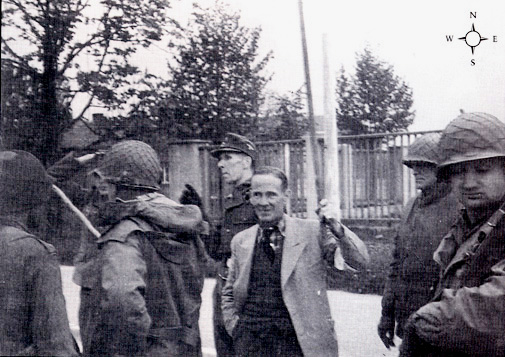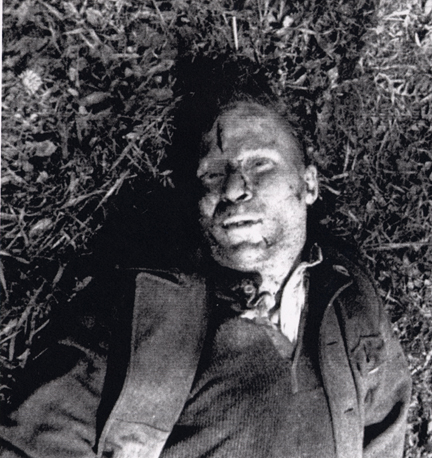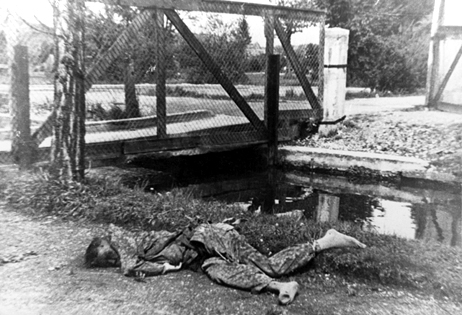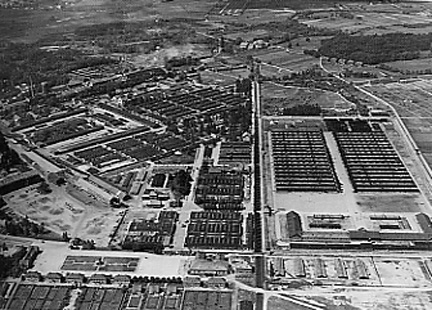Surrender of the Dachau campPrevious"Up until April 29, 1945, the majority of us in my unit were not aware of the Nazi efforts to exterminate the Jews - certainly not its scope, nor its effect on the world; and certainly none of us were aware of the Dachau Concentration Camp. We had been briefed Stateside on the unjust imprisonment of large numbers of people by the Germans, and their being forced into a kind of slavery. But nothing could have prepared me for what was to unfold in that small dorf north and west of Munich in Bavarian Germany." Lt. Jack E. Westbrook, Anti-Tank Company, 222nd Regiment, 42nd Division of the US Seventh Army.  The photograph above shows Red Cross representative Victor Maurer, wearing civilian clothes, and holding a stick with a white flag on the top of it. Behind him is SS 2nd Lt. Heinrich Wicker who has just formally surrendered the Dachau concentration camp to the 42nd Rainbow Division of the US Seventh Army. The fence in the background surrounds the SS garrison that was right next to the camp. Note the scar on the side of Wicker's face. Before being assigned to duty in the concentration camp system, Wicker had been a Waffen-SS soldier who suffered a bullet wound to the jaw while fighting in combat on the Eastern front. According to Nerin E. Gun, a Turkish prisoner at Dachau who wrote a book called "The Day of the Americans," which was published in 1966, the SS men had decided to defend the camp with machine guns located in the towers. Col. Howard Buechner, a medical officer in the 45th Thunderbird Division, used Gun's account in his book "The Hour of the Avenger." Quoted below, from a book of memoirs entitled Dachau 29 April 45 which was edited by Sam Dann, is the account of Corp. Robert W. Flora, H Company, 222d Regiment, 42nd Rainbow Division: I was in on that battle for Dachau - and this is what I remember: There wasn't very much resistance in the town, itself. But then, we moved along those railroad tracks. This is when we really started to hate the Germans. My machine gun was front-mounted on my jeep. Col. Downard said to me, "You're the man. Go out in front and lead us in. I said to him, "Colonel, I came this far. Do I have to get killed now?" You could say things like that to Downard. Well, we had put up a loudspeaker calling on the SS to surrender, but they wouldn't. And so, Downard said to me, "If we try to blast 'em out with artillery, we'll kill too many innocent people. It's Infantry time." So we moved forward. A German machine-gunner, from a tower, pinned us down for a bit. We got rid of him and moved on through the Main gate - I think it was. As we started in, we were held up again by a machine gun that was firing at us from a window in one of the buildings. He would give us a burst, duck away, and then give us another short one. I just set the sights of my Heavy-Thirty (thirty-caliber, water-cooled machine gun) on that window and waited for him to rise up again. When he did, I got him. Then, I remember that huge mass of prisoners just milling around. We saw terrible things - people lying in heaps - all dead. And, of course, all those corpses in the furnace room. What a horrible sight to see! We captured some of the guards. They were lucky that we took them alive. The ones that we didn't kill or capture were hunted down by the freed inmates and beaten to death. I saw one inmate just stomping on an SS Trooper's face. There wasn't much left of it. S/Sgt. Ralph Miller from Mora, Minnesota, a soldier in the 42nd Division, was also there that day, moving along the railroad tracks towards the Dachau camp. In an e-mail to me, his nephew Peter Miller gave the following account of Ralph Miller's story, as told to him by his father, Ralph's brother: He told me how Ralph and another guy from MN were going through the woods on April 29, 1945. They came across a large encampment surrounded by barbed wire. My dad says that Ralph didn't then know what it was. He ordered the SS guard to surrender in broken German. The guard refused and shot at them. He pleaded and tried to explain that the main American army was coming. Ralph had to shoot the guard and the two went to the gate and shot the lock. Upon entering the encampment, Ralph found out he was in a prison camp (concentration camp). My dad says that he never wanted anyone to know about this as he was embarrassed for his German ancestors. My father was very affected by what my uncle saw and told him. My dad also mentioned that Ralph had pictures and showed them to my dad when they were back on the farm in Mora, Minnesota. Ralph showed them to him, then took them outside and burned them. He didn't want anyone to have to see what he encountered in Dachau. My dad did say that Ralph saw first hand the awful things that the Nazis did to those people. I asked about the woods and my dad corrected me and said that Ralph found the camp by accident. They were looking for ammo dumps and store houses. Dad said that Ralph had orders to shoot anyone that didn't surrender. He knew how to ask, but whoever he asked in Dachau refused. My dad did reiterate that Ralph did shoot guards in a tower that refused to surrender. The following is a description of the surrender of the Dachau camp written by Paul M.G. Levy, a former Professor of the University of Strasbourg and the Catholic University of Leuven. A native of Belgium, Levy was arrested as a Communist political prisoner by the Nazis and imprisoned for a year at Breendock in Belgium before he was released. He was a reporter for the British Broadcasting Company, following the American troops, when he was invited by Brig. General Linden to accompany his party to Dachau as an interpreter. Levy was particularly interested in the liberation of Dachau because one of the prominent prisoners there was Arthur Haulot, a political prisoner, who became a member of the Belgian Parliament after the war. Levy's words are quoted from the book entitled "Dachau 29 April 1945": A white flag floats from a Guard Tower. A civilian with a Red Cross Flag comes to us. He is followed by two SS - one a lieutenant, the other, a plain trooper. They have come to surrender the Camp. I am the Interpreter. They are typically arrogant and impertinent. They still insult their victims: "These are dangerous prisoners. Watch out for your soldiers!" The Red Cross Man feels it necessary to add that they are also "crazy." The Officer says he will only surrender to armed, uniformed Americans because he still insists that "...the prisoners are too dangerous!" Linden asks him to explain the train with the cadavers. He says he knows nothing about it. Just then, despite the White and Red Cross Flags, we are fired on. Linden, with blows from his cane, forces the officer to the ground. Another description of the liberation, quoted in the same book, was written by T-5 William Veitch. He was the twin brother of 20-year-old John Veitch who accompanied Brig. General Linden when he accepted the surrender of the Dachau camp on April 29, 1945. Below is William Veitch's account, which was told to him by his brother, John, after the war. The camp commandant came out carrying a white flag, evidently in an attempt to surrender. The general said to my brother, "Veechems, go get that Kraut!" John did so and took the flag away from the officer. Then General Linden said, "Tell that Kraut to put his hands on his head." Either the "Kraut" didn't understand my brother's command, or he refused to obey. John then called back to the General. "I did, General, but he won't do it." The general strode over to the German and, with his stick, gave him a whack on the head. The German caught on. According to author Sam Dann, half of the 42nd Division liberators were teenagers who were overwhelmed by the sight of the Dachau camp and the Death Train. Some of the men of the 42nd Division were Jewish and could communicate with the prisoners in German or Yiddish. Dann wrote about 26-year-old Cpl. Morris Eisenstein, a Polish Jew from Chicago, who offered one of the prisoners 15,000 marks that he had taken from the bodies of SS soldiers killed in combat just the night before. The prisoner refused the money because he had nothing to give him in return. Eisenstein told the prisoner that he would take the yellow Star of David pinned to his clothing in exchange. The trade was made and Eisenstein kept the yellow Star, which he had encased in plastic, as a reminder of that day. Dann quotes Eisenstein in his book: We were approached by many of the prisoners who begged us for guns so that they could kill some of the remaining guards. Many of us carried extra weapons and gave them out. Unfortunately, those guards upon whom they exacted vengeance were not the officers or other big-shots because the most notorious of the SS criminals had already melted way.  Technical Sergeant Robert Parker Woodruff, a soldier in the 42nd Rainbow Division, who saw the Dachau camp on May 1, two days after the liberation, wrote the following in a letter to his parents, which was published in his home town newspaper: "The camp must have been a German SS (storm trooper) garrison, because their flag and the Nazi flag were also strewn all over the place, along with the dead German SS troopers. When the Infantry came in, the slave laborers broke loose and started beating and cutting up the SS troopers, and that was a sight. There would be a leg here, an arm there, a hand and a few fingers someplace else. I remember one storm trooper I saw, his head completely smashed; he had no face at all." Tec 3 James W. Creasman wrote the following in a 42nd Division News Letter on May 1, 1945: At least 25 and perhaps 50 (guards) were beaten to death by inmates who struck with all the fury of men who release years of pent-up hate. One was lying beside his own bloody artificial limb with which his brains had been exposed. [...] One in a railroad car had no face left. These once swaggering Hitler-worshipers would pocket no more profits from the hair-oil, shoe-polish, thermos bottles, notebooks, stationery, brushes, porcelain works of art, and cigarette paper manufactured there by men and women from all of Europe who slaved until starvation and disease made them worthless and then they were burned. A new book, entitled "Legacies of Dachau," by history professor Harold Marcuse, mentions that 2nd Lt. Wicker, who surrendered the Dachau concentration camp, was killed by the American liberators. On page 52 of his book, Marcuse wrote: In the night after the insurgency, SS officer Wicker was left in charge of the complex with about 560 troops, some of whom were Hungarian SS, and some of whom had been in the SS's disciplinary prison within the camp. At 7 a.m. a white flag was raised on the main gate of the SS complex, but guards remained in the watchtowers to keep the prisoners in check. When the first unit of US soldiers arrived, Wicker did in fact surrender the camp. However, there was some sniper and machine-gun fire from within, and the American soldiers were not inclined to treat the camp personnel they found as normal POWs. At the slightest provocation or hint of provocation, captives and men in the process of surrendering were gunned down, perhaps forty to fifty of them, including Wicker. In these first hours the Americans also refrained from intervening when survivors attacked the most brutal of their former tormentors and informants. 1st Lt. Cowling mentioned, in the letter to his parents on April 30th, that he had taken all the weapons from the guards who had surrendered to him and then "gave away all but two" of the pistols. In the same letter, Cowling went on to say that "Our troops arrived about that time and took the rest of the guards, Germans (who during all this time had remained in the towers around the prison.) A number of them and I sincerely regret that I took the eight prisoners that I did after a trip through Camp which I shall describe in a minute." On his trip through the camp, Cowling wrote that he had seen the gas chamber disguised as a shower room, where prisoners had died "in two minutes" after being poisoned by gas coming through the shower heads. Unknown to 1st Lt. Cowling was the fact that the guards in the towers, who had surrendered, were not the regular guards, most of whom had escaped the day before. The SS men in the towers were replacements, including some of the 128 SS soldiers who were prisoners at Dachau. In his letter to his parents, Cowling wrote: The Germans I took prisoner are very fortunate they were taken before I saw the Camp. I will never take another German prisoner armed or unarmed. How can they expect to do what they have done and simply say I quit and go scot free. I know now why our men kick and abuse the German prisoners. They are not fit to live. Some of the guards, whom Lt. Cowling considered "not fit to live" were killed by the American liberators and others were beaten to death by the prisoners.  The photo above shows the body of an SS soldier wearing camouflage clothing, which indicates that he was one of the Waffen-SS soldiers who were sent from the battle front to surrender the Dachau camp to the Americans. His body is lying near the moat which separated the prison enclosure from the SS garrison at Dachau. Note that his boots have been removed. Nerin E. Gun, a prisoner at Dachau, wrote the following in his book "The Day of the Americans": For, as soon as they saw the SS men standing there with their hands on their heads, these Americans, without any other semblance of trial, without even saying a warning word, turned their fire on them. Most of the inmates applauded this summary justice, and those who had been able to get over the ditch rushed out to strip the corpses of the Germans. Some even hacked their feet off, the more quickly to be able to get their boots. The aerial photograph below shows the whole Dachau complex. On the left side is the SS Training Camp and garrison where Waffen-SS soldiers were stationed. The rectangular area on the right is the concentration camp. One can see the two rows of barracks buildings and the roll call place in front of the barracks. The U-shaped building is the service building where the kitchen, laundry and showers were located. The buildings just to the left of the roll call place were factory buildings, where the prisoners worked. The prison enclosure was separated from the SS garrison by the Würm river, running in a concrete canal, and a barbed wire fence. Outside the complex, in the upper right hand corner, one can see the experimental farm where some of the prisoners worked.  The first unit of American soldiers had arrived at Dachau with the 45th Division of the US Seventh Army, approaching the complex from the northwest. They were inside the garrison in the morning hours, before the 42nd Division soldiers got to the concentration camp. The Soldiers of I Company, 3rd Battalion, 157th Infantry Regiment of the 45th Division were the first to enter the 20-acre Dachau complex through the open railroad gate on the west side of the SS garrison on the morning of April 29, 1945. Arthur Haulot, a political prisoner from Belgium, said that the regular SS "Death's Head" guards had already left the camp the night before the Americans got there, and that a unit of Waffen-SS soldiers had arrived from the front to surrender the camp. Col. Howard Buechner of the 45th Division wrote in his book "The Hour of the Avenger" that a company of 200 Waffen-SS soldiers had arrived the day before to replace other Waffen-SS soldiers who had deserted from the Dachau garrison. The Waffen-SS soldiers in the garrison were completely separate from the SS soldiers who guarded the concentration camp, although the SS guards were also quartered at the garrison. In his book "The Hour of the Avenger," Col. Buechner wrote "When German Lieutenant Heinrich Skodzensky, who was camp commander on the day of liberation, attempted to surrender, he stated that he was turning over 560 German garrison troops." There are no SS records for Lt. Skodzensky and no record of 560 SS soldiers being at Dachau on April 29, 1945. There are no records for Heinrich Skodzensky in the Dachau archives nor in the Berlin Bundesarchiv. According to Buechner, the full strength of the garrison was 1,473 men, the figure which is usually given for the number of men who left on the night of April 28th. A group of around 150 guards from the evacuated sub-camps of Natzweiler, commanded by 2nd Lt. Heinrich Wicker, were all that was left to man the guard towers until the camp could be turned over to the Americans. Wicker formally surrendered the concentration camp to Brig Gen. Henning Linden at a place close to the gate near the southwest corner of the SS garrison. The photograph below shows a dead SS soldier lying on the ground and another SS soldier just before he was shot by the American liberators, according to Donald E. Jackson, who contributed this photo.  PreviousMore about 2nd Lt. Heinrich WickerExecution of Waffen-SS soldiersThe killing of the Guards in Tower BBack to Liberation of DachauBack to Table of ContentsHomeThis page was last updated on June 25, 2008 |